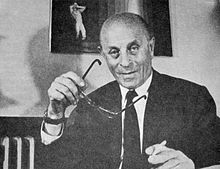
Biography of Ladislao Biro. Ladislao José Biro, or in his original language László József Bíró, was born on September 29, 1899, in the city of Budapest, belonging to the Kingdom of Hungary, and died on October 24, 1985, in the city of Buenos Aires , Argentina. He is widely recognized for his work as an inventor, with at least 32 creations in total, among which the construction of a machine to wash clothes, a high security lock and which earned him his great fame stand out; the pen. His work as a journalist is also an important part in the construction of his fame, as his writings were of remarkable quality. In addition, thanks to said office he conceived the idea of the pen. At the time of being conceived, Ladislado suffered a low level of weight, which generated in the doctors the idea that the newborn would not last long, notifying the family that they would abandon it in any place. Due to this fact his grandmother took a box of shoes, completely lined it with cotton, in addition to adding a small lamp that would keep the infant's temperature. This improvised incubator would be the one that would save his life. His home was of humble character and was located in Nagymező street, in the city of Budapest. The family was ascribed to the Jewish religion. His father Mózes Mátyás Schweige earned his living as a dentist, while his mother Janka née Ullmann, performed in the respective tasks to raise their children and maintenance of the home. In the family nucleus, Ladislao also had a brother named György Bíró. The difference in the surname with that of their parents due to the error of a notary. As a child he showed great curiosity to investigate those aspects that were clearly of interest, so he skipped classes or even went to them to satisfy his hunger for knowledge. Maintaining this characteristic throughout his life he was formed as a man cultured in various branches of wisdom. At the end of his studies he began his professional work, performing journalism work and even editing for the Hongrie Magyarország Hungary newspaper. In addition to this, he tried in his native city to pursue a professionalization in medical studies, but in the end he ended up not graduating in such knowledge. He also carried out exhaustive practices and research on elements such as hypnosis, painting, motorsport and ants. Due to the ravages that the Second World War was causing, he decided to travel to the country of Argentina in 1940, accompanied by his brother, later his wife Elsa Schick and his daughter Mariana Biro would accompany him. In Argentina he would settle in the city of Buenos Aires, where he would continue with his profession as a journalist. In this environment came the idea of the construction of the pen, because he was left handed using the fountain pen always represented a problem, delaying the creation process regarding his reports, clogging the ink, because it did not flow well, since the structure is only designed for use by right-handed people. In the company of his brother they improved this aspect by creating a new ink that was more effective and manageable in terms of manual writing, however it did not work well on the pen. Ladislao solved this problem by seeing some children playing ball and after it was thrown into a puddle he would draw a path, realizing that the best option was a point that would have a sphere at the end. After receiving help from Argentine President Agustín Pedro Justo to perfect and patent the idea, on June 10, 1943, the product was launched into the market with the name of Birome. Due to the slightly high cost and the daily use of the pen, it went very unnoticed and barely had any interest in the Birome. However, when it began its apogee, it became an economic success not only for Ladislao, but also for Argentina, which distributed it around the world. For this reason his name has undergone different transformations according to the place, being only used the name of Birome in Argentina. After the success of the Birome, the long list of inventions and patents of Ladislao began to be taken into account. Among his ideas and creations are: a machine for washing clothes (1930), the sketch of electromagnetic system (1936), an automatic gearbox for automobiles (1932), a method to improve the hardness of steel rods ( 1944), a mechanism that extracted energy from the movements that possess the waves of the sea (1958), among many others. His life would come to an end on October 24, 1985. Argentina as a tribute distributed a series of stamps with his image, in addition to establishing the day of his birth as the inventor's day. https://leyesyciencia.blogspot.com/.